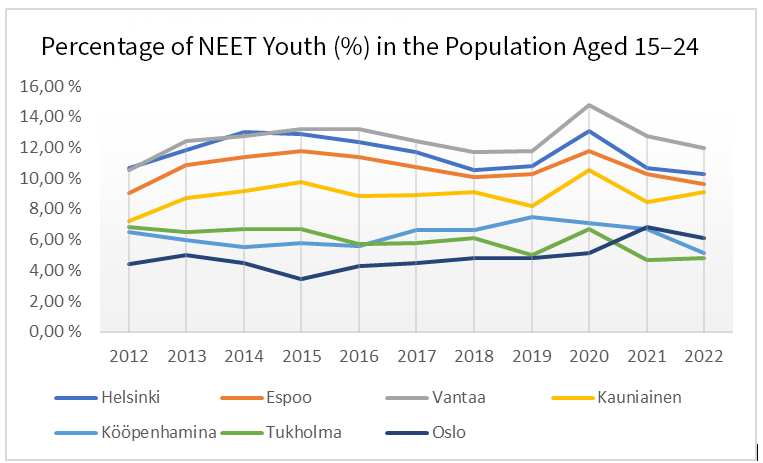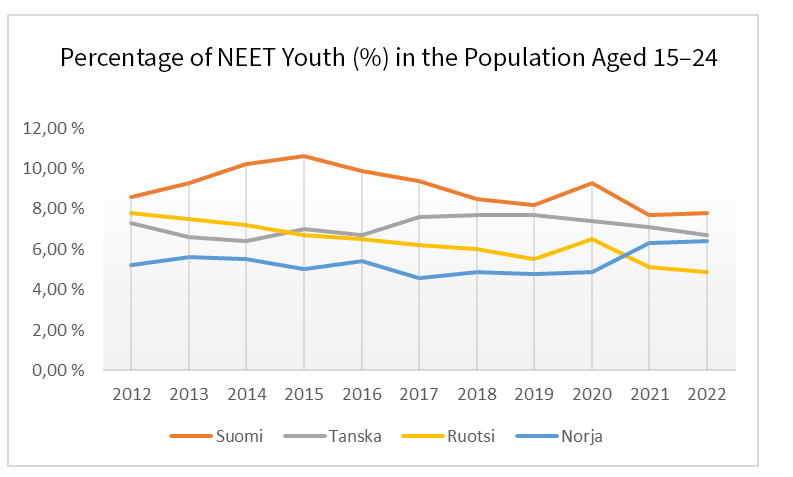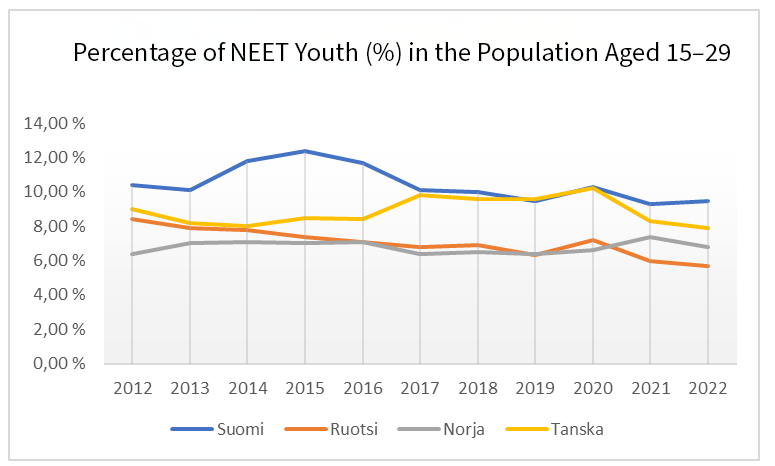Youth exclusion is a major risk to the economy. It increases the costs of income support, disability pensions, and health care, alongside the distress and difficulties it causes to individuals.
To ensure that the Helsinki Metropolitan Area’s labour market will continue to have access to talented people in the future, we must look after young people’s education, and their integration into working life.
At The Ami Foundation, we have compiled the latest figures on NEET youth in the Helsinki Metropolitan Area.
The NEET acronym comes from the definition of Not in Employment, Education or Training, which describes the proportion of young people aged 15–24 who are not in education, employment, or military service. Alternatively, the NEET rate can also apply to the age group 15–29, but in Finland, for example, Statistics Finland uses the age group 15–24 which is also the point of reference in this blog.
The information gathered from the Helsinki Metropolitan Area shows that effective action is needed to catch up with other Nordic capital regions, and the EU target level.
We need comparative data between the Nordics
The sizes of age groups have been declining in Finland and many other Western countries for a long time, and it is likely that this trend will continue in the future. At the same time as the sizes of age groups are shrinking, our labour markets are facing labour shortages.
In this situation, we need to help all young people to gain a foothold in working life. We cannot afford to allow young people to be marginalised, and drop out of the labour market.
According to The Ami Foundation’s vision, the Finnish capital region will have the best labour market in the Nordic countries in the future. To achieve this vision, we must pay special attention to young people, and find solutions to prevent them from falling out of education and the labour market.
From a Nordic perspective, it is also important to compare the situation of young people in the Finnish capital region with other Nordic capital regions, and to produce comparative research on the subject, so that we can learn from practices that have been proven to be effective.
A threat to both the individual and the economy
The NEET indicator is a fairly effective way of scoping young people’s situation, and their risk of exclusion. As NEET youth often experience a combination of economic and human challenges, it is essential to address the factors leading to a protracted situation as a whole.
From a labour market perspective, exclusion has unwanted consequences, as employers facing labour shortages lose potential employees and future talent.
Youth exclusion also results in a multiplier effect on the labour market, as long periods of unemployment and dropping out of education and training at a young age foretell an increased risk of unemployment later in life.
However, it should be noted that the NEET youth status is not synonymous with marginalised youth. NEETs also include young people who are out of employment, education and training for a short period of time. For example, a young person who has completed their Finnish military service may be waiting to start their studies, or a spring graduate may be waiting to start work later in the autumn.
NEETs without upper secondary education at particular risk
A report published by the Diaconia University of Applied Sciences on Promoting Youth Inclusion shows that if the NEET period is prolonged, it also increases the risk of exclusion. It is therefore a concern if a young person has no job, education or training place to look forward to.
While this blog talks about young people from a working life perspective, it is important to note that NEET youth also include those who are disabled or incapable for work, and need pathways to rehabilitation and access to health services rather than employment.
We can identify factors that increase the risk of prolonged NEET status, leaning on data from Statistics Finland and the above-mentioned Diaconia report.
Cross-generational deprivation and the associated low socio-economic status of parents, experiences of bullying at school, substance abuse problems from a young age, dropping out of school, teenage motherhood, immigrant background, and being subject to child protection measures are some of the factors that increase the risk of being excluded from employment, education and training at a young age.
Young people who have not completed upper secondary education are at particular risk.
There are fewer and fewer jobs available that do not require an education, and at the same time, skills requirements in the labour market are changing rapidly. Young people who are not educated are therefore at risk of falling into long-term unemployment or precarious employment.
Solutions through stakeholder cooperation
Young people who fall out of education and employment often face different challenges simultaneously, and, as such, young people with a prolonged NEET status are not a homogeneous group. Solutions to these challenges must therefore be sought through cooperation between different stakeholders.
In particular, cooperation is needed between employment, social, health, and youth services, and educational institutions.
In Finland, with the transfer of responsibility for employment services from the state’s employment and economic development offices to municipalities at the beginning of 2025, the new employment areas in the Helsinki Metropolitan Area will have the opportunity to develop more effective services and pathways to work for young people, to prevent them from falling outside of the labour market.

It is also important to produce up-to-date research data on NEET youth and their situation in the capital region, so that challenges can be properly addressed.
It would be useful to have new research on service bottlenecks, and the perceptions of different stakeholders on the development of services. We shouldn’t also forget employers in the capital region, with whom we need to engage in dialogue on new solutions to improve and develop the integration of young people into working life.
The EU’s target threshold still unattained
The European Commission has set a target for its Member States to reduce the share of NEETs in the 15–29 age group to 9% by 2030. The EU’s concern on this issue underlines the importance of preventing the exclusion of young people.
The latest figure for the share of NEETs across the EU was 11.7% in in the 15–29 age group in 2022, and 9.6% in the 15–24 age group, which implies that the target is well within reach by 2030 for both groups. Over the past decade, the development has been positive, with a 3.5% decrease in the EU as a whole.
In the Helsinki Metropolitan Area, however, the share of NEETs needs special attention. In Helsinki, Espoo and Vantaa the NEET share of 15–24-year-olds is still over 9%. In the period 2012–2022, the share has not once fallen below the EU target, but has stubbornly remained around 10–12% (Figure 1).
On a positive note, the NEET rate in Kauniainen fell below 9% in 2019 and 2021, while in the wider Helsinki-Uusimaa Region the NEET rate has already fallen below 9% in the 15–29 age group.
Finland has more NEET youth than other Nordics
The comparison with other Nordic capital regions is alarming. In Stockholm County, for example, the share of NEET youth has fallen below 5%. In the city of Stockholm, the figure for 15–24-year-olds is 6%, well below the figure for municipalities in the Finnish capital region.
A Nordic comparison shows that, in other Nordic capital regions, NEET rates are 4–5% lower than in the Finnish capital region. Finland’s NEET rate for the 15–29 age group was above 9% between 2018 and 2022, while Norway, Sweden and Denmark have had lower rates than Finland over the same period. In Norway and Sweden in particular, the rate has remained significantly lower than in Finland.
Although Finland’s NEET rate is higher than in the other Nordic countries, Finland has already almost reached the EU’s target of 9% by 2030.
The latest national figure was 9.5% for the 15–29 age group. Although Finland has managed to fall below the 9% threshold for 15–24 year olds, the NEET rate is still higher in this age group than in the other Nordic countries (Figures 2 and 3).


It’s self-evident that we at The Ami Foundation are therefore very interested in the measures and research that other Nordic countries have carried out to reduce the share of NEET youth. Perhaps we could learn from good practices in other Nordic countries, and develop new solutions to address local challenges in the Helsinki Metropolitan Area.
We believe that we in the Finnish capital region have every opportunity to bring the NEET rate down to the level of other Nordic countries. More and more young people need to be involved in employment, education and training.
Sources used in the text include Statistics Finland, Eurostat, MUCF (Myndigheten för ungdoms- och civilsamhällefrågor).
